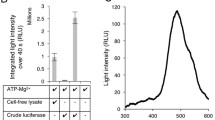Abstract
The evolutionary origin of beetle bioluminescence is enigmatic. Previously, weak luciferase activity was found in the non-bioluminescent larvae of Tenebrio molitor (Coleoptera: Tenebrionidae), but the detailed tissular origin and identity of the luciferase-like enzyme remained unknown. Using a closely related giant mealworm, Zophobas morio, here we show that the luciferase-like enzyme is located in the Malpighi tubules. cDNA cloning of this luciferase like enzyme, showed that it is a short AMP-ligase with weak luciferase activity which diverged long ago from beetle luciferases. The results indicate that the potential for bioluminescence in AMP-ligases is very ancient and provide a first reasonable protoluciferase model to investigate the origin and evolution of beetle luciferases.
Similar content being viewed by others
References
K. V. Wood, The chemical mechanism and evolutionary development of beetle bioluminescence Photochem. Photobiol. 1995 62 662–673.
V. R. Viviani, The Origin, Diversity and Structure Function Relationships of Insects Luciferases Cell. Mol. Life Sci 2002 59 1833–1850.
J. W. Hastings, Biological diversity, chemical mechanisms and evolutionary origins of bioluminescent systems J. Molecular Evolution 1983 19 309–321.
J. F. Rees, B. De Wergifosse, O. Noiset, M. Debuisson, B. Janssens, M. E. Thompson, J. Exp. Biol 1998 201 1211.
V. R. Viviani and J. H. Bechara, Larval Tenebrio molitor (Coleoptera: Tenebrionidae) fat body extracts catalyze d-luciferin and ATP-dependent chemiluminescence. A luciferase-like enzyme Photochem. Photobiol. 1996 63 713–718.
Y. Oba, M. Sato and S. Inouye, Cloning and characterization of the homologous genes of firefly luciferase in the mealworm beetle, Tenebrio molitor Insect Mol. Biol. 2006 15 293–299.
V. R. Viviani and Y. Ohmiya, Bovine serum albumin displays luciferase-like activity in presence of luciferyl-adenylate: insights on the origin of protoluciferase activity and bioluminescence colors Luminescence 2006 21 262–267.
E. Conti, N. P. Franks and P. Brick, Crystal Structure of Firefly Luciferase Throws Light on a Super Family of Adenylate-forming Enzymes Structure 1996 4 287–298.
T. Nakatsu, S. Ichiyama, J. Hiratake, A. Saldanha, N. Kobashi, K. Sakata and H. Kato, Structural basis for the spectral difference in luciferase bioluminescence Nature 2006 440 372–376.
B. R. Branchini, R. A. Magyar, M. H. Murtishaw, S. M. Anderson and M. Zimmer, Site-directed mutagenesis for histidine 245 in firefly luciferase: a proposed model of the active-site Biochemistry 1998 37 15311–15319.
B. R. Branchini, R. A. Magyar, M. H. Murtishaw and N. C. Portier, The role of active site residue arginine 218 in firefly bioluminescence Biochemistry 2001 40 2410–2418.
V. R. Viviani, A. J. Silva-Neto, F. G. C. Arnoldi, J. A. R. G. Barbosa and Y. Ohmiya, The influence of the loop between residues 223-235 in beetle luciferase bioluminescence spectra: a solvent gate for the active site of pH-sensitive luciferases Photochem. Photobiol. 2007 83 1–7.
V. R. Viviani, F. M. Okawachi, V. Scorsato and F. C. Abdalla, CCD imaging of basal bioluminescence in larval fireflies: clues on the anatomic origin and evolution of bioluminescence Photochem. Photobiol. Sci. 2008 7 448–452.
K. M. Knights and C. J. Drogemuller, Xenobiotic-CoA ligases: kinetic and molecular characterization Current Drug Metab. 2000 1 49–66.
W. C. Dauterman, in Comprehensive Insect Physiology, Biochemistry and Pharmacology, ed. G. A. Kerkut and L. I. Gilbert, Pergamon Press, New York, 1985, 18, pp. 713–730.
J. B. Gattenby, The Australasian mycetophilid glow-worms. Trans. R. Soc. N. Z. 1960 88 577–593.
D. L. Swofford, PAUP. Phylogenetic, Analysis Using Parsimony (and Other Methods), Version 4, Sinauer Associates, Sunderland, Massachusetts, 1998.
N. Saitou and M. Nei, The neighbor-joining method: a new method for reconstruction of phylogenetic trees. Mol. Biol. Evol. 1987 4 406–425.
V. Makarenkov, T-Rex: reconstructing and visualizing phylogenetic trees and reticulation networks Bioinformatics 2001 17 664–668.
Author information
Authors and Affiliations
Corresponding author
Rights and permissions
About this article
Cite this article
Viviani, V.R., Prado, R.A., Arnoldi, F.C.G. et al. An ancestral luciferase in the Malpighi tubules of a non-bioluminescent beetle!. Photochem Photobiol Sci 8, 57–61 (2009). https://doi.org/10.1039/b817114a
Received:
Accepted:
Published:
Issue Date:
DOI: https://doi.org/10.1039/b817114a




